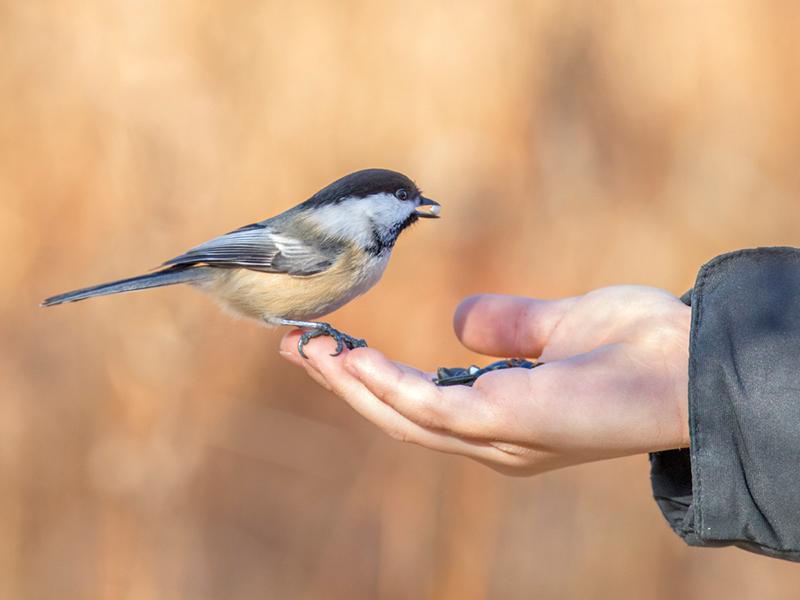City ornithologist Juliet Berger calls the chickadee a birder’s best friend. Because chickadees are usually the first birds to find food, other songbird species seek them out–so birders searching for migrating songbirds in the spring look for chickadees. Birds and birders both converge on chickadees: Cherchez les chickadees!
Chickadees are year-round residents, but they pay a high price for staying the winter. Their feathers provide some insulation, and, if need be, they can lower their body temperature several degrees–an energy-conserving state called torpor. Even so, one estimate places the mortality rate at around 25 percent, perhaps double that during a really bad Michigan winter.
Our local black-capped chickadees are energetic, active to the point of being somewhat acrobatic, and friendly. They are relatively fearless around people, as illustrated by our photo of a chickadee eating out of a young boy’s hand at Kensington Metropark. However, don’t be disappointed if a chickadee does not come to your hand. Kensington has a birdseed vending machine, and visitors have been hand-feeding birds for many years. Berger thinks that Kensington chickadees actually train their young to seek food in this manner. Our remaining images are of local chickadees.
Chickadees shelter at night in cavities, preferring ones they have fashioned themselves in dead trees by excavating rotten wood. In summer, they’ll also nest in natural cavities or man-made boxes. Many nesting boxes also are used by bluebirds, house sparrows, and house wrens, all of which are capable of evicting a small, mild-mannered chickadee. Different nesting times and different habitat preferences help alleviate cavity competition.
While chickadees may be a birder’s best friend because of their ability to attract other birds, they are other birds’ best friends for another important reason: the alarms they sound when they sense a predator. Berger says these aren’t just generic warnings: variations can indicate the nature and size of the threat and whether it is flying or terrestrial.
The seminal piece on chickadee alarms appeared in the June 2005 issue of Science magazine, with the authors dryly remarking: “This study demonstrates an unsuspected level of complexity and sophistication in avian alarm calls.” The bird studied was the black-capped chickadee.
Equally amazing, more than fifty other bird species pick up on chickadee alarms and react accordingly–whether by fleeing or organizing resistance. A 2016 article in Living Bird magazine (allaboutbirds.org/look-out-the-backyard-bird-alarm-call-network) describes how a chickadee’s alarm about a sharp-shinned hawk in a tree “ricochets from chickadees to nuthatches to titmice to jays and soon an angry horde of songbirds arrives to mob the intruder.”
Black-capped chickadee language isn’t limited to songs and alarms. The Cornell Lab of Ornithology says that flocks “have many calls with specific meanings, and they may contain some of the characteristics of human language.”
Chickadees are pretty little birds that bring life to an otherwise still winter landscape. But there is a lot of intelligence packed into those little bird brains. Hooray for chickadees!


